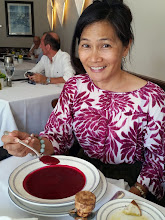The first time I ever had
chawan-mushi was with Hata-
sensei at
Casa Arigato. The second and third times I had it were also with Hata-sensei at Casa Arigato. Jolene, who has eaten at almost every Japanese restaurant in the Los Angeles area, has only encountered this dish in Japan. It is a very home-style Japanese comfort food that is somehow missing from that cuisine’s bill of fare in the good old U.S. of A.
The savory steamed egg custard – whose name translates to
“tea cup steam,” - is usually served in those lovely covered
cups that you see in stores that sell Japanese housewares. Casa Arigato’s version of chawan-mushi arrives at the table in a blue and white teacup reminiscent of
Delft pottery from the Netherlands, with a windmill painted on it and a small wooden spoon with which to eat the warming treat.
 Even in this year's November heatwave, the warming effects of chawan-mushi are still welcome.
Even in this year's November heatwave, the warming effects of chawan-mushi are still welcome.Hata-sensei informed me that this presentation may be in homage to the Dutch colony of
Deshima, an artificial island that was established in the bay of
Nagasaki in the early 1600s. He said that although the
Edo period of shogun rule from 1603 to 1868 isolated Japanese culture from outside influences, the Dutch were welcome because they were the only foreigners who did not send missionaries in order to convert the Japanese to Christianity. Instead, they brought silk and other goods from Southeast Asia, and exported
Japanese ceramics to Europe.

Dutch treat: more than two centuries of retail therapy.What’s inside the cup, however, is 100 percent Japanese. The silky texture of the
egg custard has a texture similar to soft tofu. Within it are suspended one large shrimp, shitake mushrooms, spinach, an herb called honeywort – also known as
mitsuba - and the ubiquitous
gingko nut, a sign, says Hata-sensei, of authenticity.
As a
yonsei (4th generation Japanese American) growing up in East Los Angeles, Hata-sensei says that he never ate chawan-mushi until he lived in Japan when in his early 20s. He was incarcerated at the age of three with his family at
Gila River, Arizona during World War II, from 1943 to 1945. He says that his parents – who were
Nisei - the first generation born in America to Japanese immigrants – “cleansed us of any Japanese identity, any ties to ancestral heritage. That’s what World War II did to us.”
Fast forward to Hata-sensei’s graduate studies in Japan in the late 1960s. He studied there on a Ford Fellowship, ironically financed by the
National Defense Education Act of 1958. Before he became the
revolutionary and history professor that he was – and deep down, still is – he was just another American grad student standing on a street corner, puzzling over a Japanese map of Tokyo after having misplaced his English map.
A deep-voiced man in a
Jaguar XK- E asked him if he needed some assistance. He told the man that he was an American student, looking for the Foreign Ministry Archive. The man in the Jaguar gave him directions to his destination, asked for his
meishi, and drove off.
About a month later, Hata-sensei’s landlords – a retired brigadier general and his wife who rented him a tiny
geshuku - told him that a wealthy family wanted to hire him as a live-in English tutor. He was asked to meet someone at the
Imperial Hotel, Frank Lloyd Wright’s most famous work in Japan, which at that time was still located in its original spot before being demolished in 1968.
“On the appointed day, I go,” said Hata-sensei. “The maître d’ sends me to a table in the back where a very handsome woman asked me questions in slow, elementary Japanese.”
The young student was told by his interviewer that his presence would be required at mealtimes, during which he was expected to converse with the family – a father, mother, and two sons – in English only, the better to bring their disparate conversational skills in this foreign tongue to a collectively equal level. After another month, his landlords informed him that the wealthy family had sent for him to live with them.
Hata-sensei strapped his few belongings – a bookcase and steamer trunk – onto the back of a motorized bike that served as a taxi and was taken to an imposing English Tudor-style house. He was welcomed by a distinguished looking gentleman who he assumed was the family’s butler. The man served him a brandy before going out into the rain to fetch his luggage. Finally, Hata-sensei recognized him.
“It was
Toshirô Mifune,” he said. “He was about my height and had scoliosis also. He and I sat there for two hours talking.”
During the year that Hata-sensei spent in the Mifune household, there were a few adjustments to be made, particularly for a Japanese American college student who had to adapt to the communal household
bathing ritual.
“I was the second oldest male in the household,” he remembers. “As such, I got to go second in the bath, even before the sons and Mrs. Mifune. I took my bath and pulled the plug on the hot water. Later on, the maids told me not to do that.”
 "You did what?"
"You did what?"Hata-sensei did, however, adapt well to other customs while living in Japan, including the long-denied authentic Japanese cuisine and the still-elusive chawan-mushi. As much as I enjoy Casa Arigato and have returned there with my family, it’s become the place I associate with him and our conversations, which always leave me feeling a bit smarter, more curious about the world’s workings, and almost capable of negotiating peaceful exchange between any two nations - especially if they have good food in pretty dishes to offer.
 Hata-sensei digs in with gusto, as always. Banzai!
Hata-sensei digs in with gusto, as always. Banzai!











